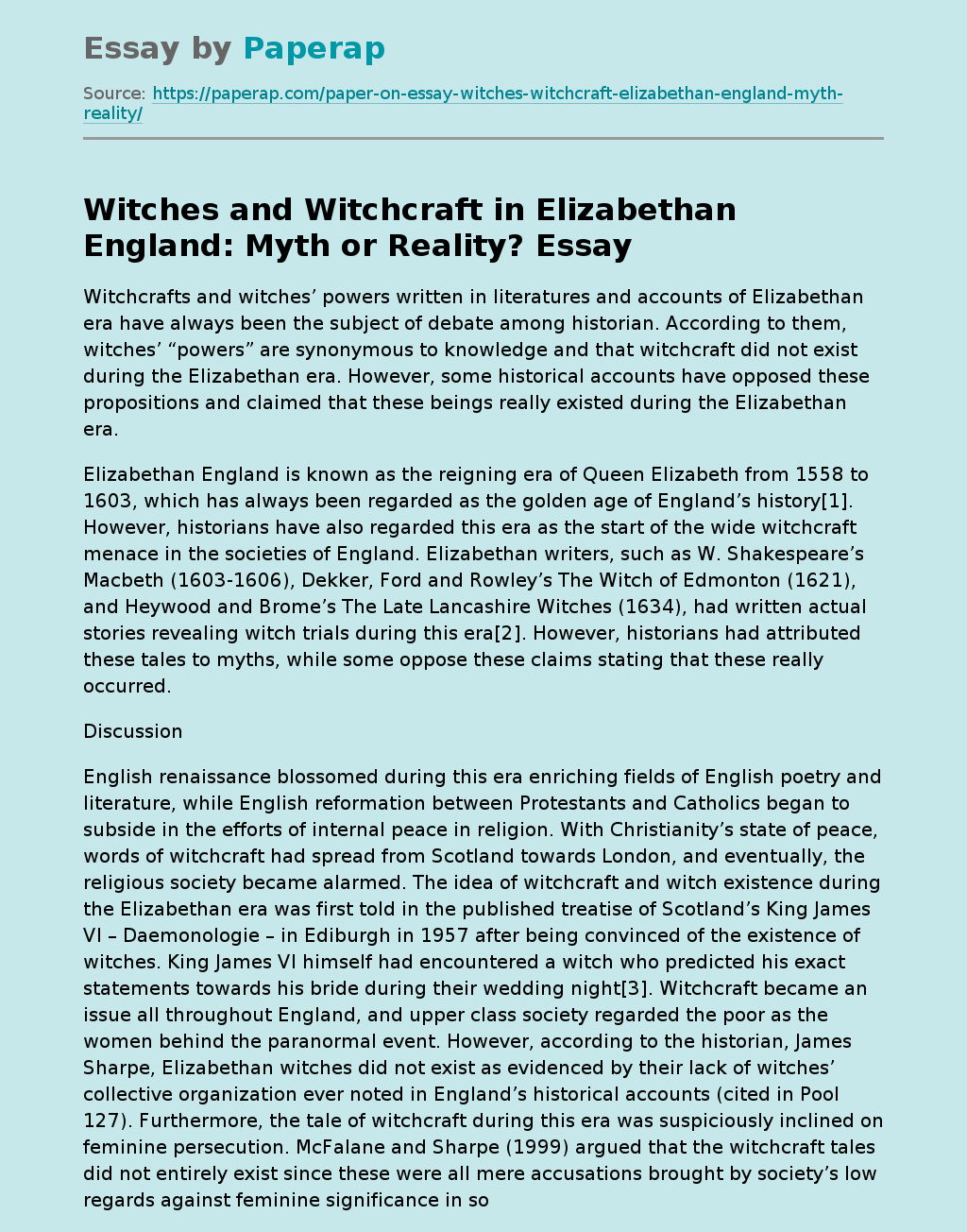Witches and Witchcraft in Elizabethan England: Myth or Reality?
Witchcrafts and witches’ powers written in literatures and accounts of Elizabethan era have always been the subject of debate among historian. According to them, witches’ “powers” are synonymous to knowledge and that witchcraft did not exist during the Elizabethan era. However, some historical accounts have opposed these propositions and claimed that these beings really existed during the Elizabethan era.
Elizabethan England is known as the reigning era of Queen Elizabeth from 1558 to 1603, which has always been regarded as the golden age of England’s history[1].
However, historians have also regarded this era as the start of the wide witchcraft menace in the societies of England. Elizabethan writers, such as W. Shakespeare’s Macbeth (1603-1606), Dekker, Ford and Rowley’s The Witch of Edmonton (1621), and Heywood and Brome’s The Late Lancashire Witches (1634), had written actual stories revealing witch trials during this era[2]. However, historians had attributed these tales to myths, while some oppose these claims stating that these really occurred.
Discussion
English renaissance blossomed during this era enriching fields of English poetry and literature, while English reformation between Protestants and Catholics began to subside in the efforts of internal peace in religion.
With Christianity’s state of peace, words of witchcraft had spread from Scotland towards London, and eventually, the religious society became alarmed. The idea of witchcraft and witch existence during the Elizabethan era was first told in the published treatise of Scotland’s King James VI – Daemonologie – in Ediburgh in 1957 after being convinced of the existence of witches. King James VI himself had encountered a witch who predicted his exact statements towards his bride during their wedding night[3].
Witchcraft became an issue all throughout England, and upper class society regarded the poor as the women behind the paranormal event. However, according to the historian, James Sharpe, Elizabethan witches did not exist as evidenced by their lack of witches’ collective organization ever noted in England’s historical accounts (cited in Pool 127). Furthermore, the tale of witchcraft during this era was suspiciously inclined on feminine persecution. McFalane and Sharpe (1999) argued that the witchcraft tales did not entirely exist since these were all mere accusations brought by society’s low regards against feminine significance in society (76). Meanwhile, some historians assert that accusations of witchcraft were only done for the purpose of social control among women of Elizabethan era, such as the story of Anne Boleyn and Perotine Massey[4]. Female society was possibly feared due to their sexual control over men, especially during cases of conception were involved. Witch accusations were also directed among women who bypassed patriarchal powers and those with strong personality. According to Travitsky and Seeff (1994), women accused with witchcraft were burned at stake to prevent them from returning to their society; thus, preventing as well their potential influence.
On the other hand, women accused with witchcraft during Elizabethan era were around 314 listed in Assize court prosecution, while majority were burned or acquitted without proper trials. Disturbingly, the fear of the public towards witches was so intense that simple petting of animals was already considered witchcraft. Women accused as witches had their familiars (normatively a black cat), and together, were burned at stake, such as the Witch trials at Chelmsford in 1566[5]. In fact, the trends of witch-hunting during this era became so intense that the higher court passed two acts (i.e. Witchcraft Act of 1542 and 1563) imposing a punishment of death against those proven practicing witchcraft[6]. Two of the most commendable records of witch trials occurred in 1566 and 1567, which evidently included paranormal manifestations. The account of the witchcraft trial in 1566 involved a widow referred as the Mother Agnes Waterhouse, who had her spotted familiar (cat) named as “Sathan”. The cat was given by the grandmother of Elizabeth Francis who, at the time of owning the cat, received various provisions of sexual requests from the cat. After owning the cat, Mother Waterhouse turned the creature to a toad to poison the poultries and geese of her neighbors. Unfortunately, Mother Waterhouse killed one of his neighbors in the process, which led her to the witches’ secular trial. Eventually, Mother Agnes’s 18-year-old daughter – Jone (or Joan) – testified against her witchcraft practices, which led her to death by the rope[7]. On the other hand, another case was filed by the young son of Elleine Smith declaring that his mother owned three spirits that she used on her witchcraft ceremonies. The trials commenced without providing the statements of the child; although, four witnesses testified on the accounts of the child, which satisfied the court judgment. Despite these events, historians defended the issue by claiming that the trends of accusations were not at all supported by the physical forms of the accused paranormal events. However, approaches of the higher authorities (e.g. King James VI, papacy, etc.) and the common members of Elizabethan society were entirely unusual to consider these accusations as products of social control towards the feminine community.
Conclusion
In conclusion, the events of witchcraft during the Elizabethan society can be considered as another form of myth due to the lack of evidences to support the claims of the actual paranormal activity. Based from the historians’ accounts, accusations of witchcraft are only parts of the social control implemented by the society to prevent bypass of patriarchal authority and to maintain the order of gender in Elizabethan society. However, unrest and skepticisms on these events may still continue until proofs of witchcraft’s existence during Elizabethan era are discovered.
Witches and Witchcraft in Elizabethan England: Myth or Reality?. (2017, Apr 22). Retrieved from https://paperap.com/paper-on-essay-witches-witchcraft-elizabethan-england-myth-reality/

